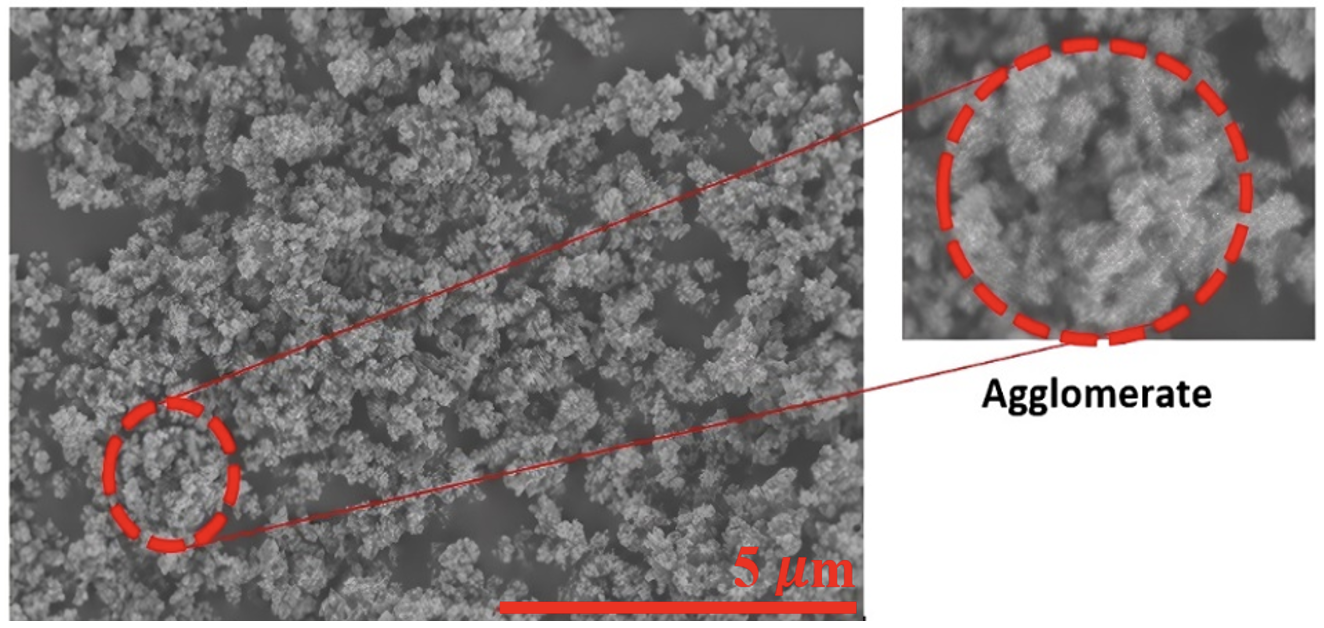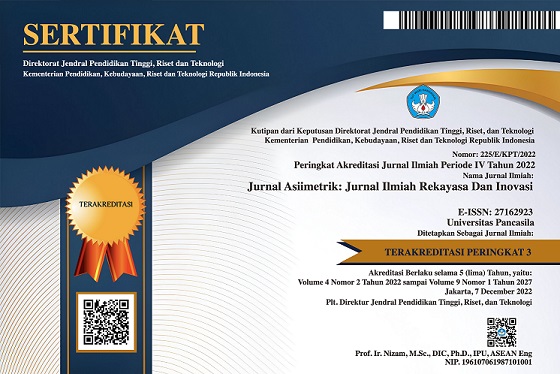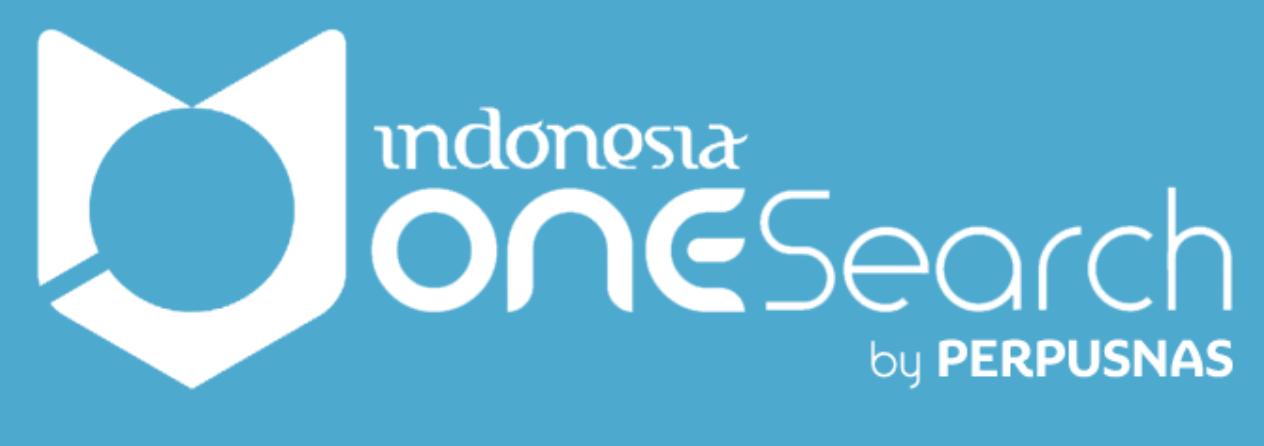The Qualitative Stability and Thermal Properties Investigation of TiO2-EG/W Nanofluids Through Experimental Validation
DOI:
https://doi.org/10.35814/asiimetrik.v6i1.5882Keywords:
stability, thermal conductivity, nano fluids, TiO2-EG/WAbstract
Over the past two decades, researchers have been extremely interested in developing TiO2 nanofluids for heat exchanger applications. Therefore, this study evaluates the performance of employing TiO2 nanofluids, which were prepared using ethylene glycol (EG) and distilled water as the base fluid, then called TiO2-EG/W. The qualitative stability and thermal conductivity properties were measured through the experimental investigation. XRD and SEM analyses were also carried out to investigate the structures of TiO2 nanoparticles used in terms of their crystalline and morphological structures. The results showed a positive impact of stability even for 15 days, and after that, the nanoparticles dropped to the sedimentation by about 58%. Then, the highest thermal conductivity at the temperature of 80 °C was increased by about 17.08% compared to the base fluid. Supported by the results of XRD and SEM analysis, respectively, highlight that TiO2 nanoparticles have a rutile phase with an average crystallite size of 20.23 nm and are small spherical in morphology. This paper also provided the challenge and future perspective of TiO2 nanofluid to appear as an innovation for the development of TiO2 nanofluid in the further studies of heat exchanger applications.
Downloads
References
Adun, H., Kavaz, D. and Dagbasi, M. (2021) ‘Review of ternary hybrid nanofluid: Synthesis, stability, thermophysical properties, heat transfer applications, and environmental effects’, Journal of Cleaner Production, 328, p. 129525.
Ali, H.M. et al. (2018) ‘Preparation Techniques of TiO2 Nanofluids and Challenges: A Review’, Applied Sciences, 8(4), p. 587.
Arifin, Z. et al. (2022) ‘The application of TiO2 nanofluids in photovoltaic thermal collector systems’, Energy Reports, 8, pp. 1371–1380.
Arsana, I.M. et al. (2022) ‘Preparation and Characterization of TiO2 Nanoparticles as Nanofluid in Double Pipe Heat Exchanger’, in International Joint Conference on Science and Engineering 2022 (IJCSE 2022), Atlantis Press, pp. 169–185.
Bai, X. et al. (2023) ‘Tribological Performance of Different Concentrations of Al2O3 Nanofluids on Minimum Quantity Lubrication Milling’, Chinese Journal of Mechanical Engineering, 36(1), p. 11.
Dehaj, M.S. and Mohiabadi, M.Z. (2019) ‘Experimental investigation of heat pipe solar collector using MgO nanofluids’, Solar Energy Materials and Solar Cells, 191, pp. 91–99.
Dharmakkan, N. et al. (2023) ‘A case study on analyzing the performance of microplate heat exchanger using nanofluids at different flow rates and temperatures’, Case Studies in Thermal Engineering, 44, p. 102805.
Dosodia, A. et al. (2022) ‘Experimental Studies and Analytical Analysis of Thermophysical Properties of Ethylene Glycol–Water-Based Nanofluids Dispersed with Multi-walled Carbon Nanotubes’, International Journal of Thermophysics, 43(12), p. 175.
Elsaid, K. et al. (2021) ‘Thermophysical properties of graphene-based nanofluids’, International Journal of Thermofluids, 10, p. 100073.
Gupta, S.K., Verma, H. and Yadav, N. (2022) ‘A review on recent development of nanofluid utilization in shell & tube heat exchanger for saving of energy’, Materials Today: Proceedings, 54, pp. 579–589.
Hamid, K.A. et al. (2015) ‘Effect of temperature on heat transfer coefficient of titanium dioxide in ethylene glycol-based nanofluid’, Journal of Mechanical Engineering and Sciences, 8, pp. 1367–1375.
Hamid, K.A. et al. (2016) ‘Experimental investigation on heat transfer performance of TiO2 nanofluids in water–ethylene glycol mixture’, International Communications in Heat and Mass Transfer, 73, pp. 16–24.
Huang, Yicheng et al. (2022) ‘Thermal management of polymer electrolyte membrane fuel cells: A critical review of heat transfer mechanisms, cooling approaches, and advanced cooling techniques analysis’, Energy Conversion and Management, 254, p. 115221.
Huang, Yushuang et al. (2022) ‘Thermophysical property evaluation of β-cyclodextrin modified ZrO2 nanofluids for microchannel heat exchange’, Ceramics International, 48(21), pp. 31728–31737.
Krishnakumar, T.S. et al. (2019) ‘Heat transfer studies on ethylene glycol/water nanofluid containing TiO2 nanoparticles’, International Journal of Refrigeration, 102, pp. 55–61.
Kristiawan, B. et al. (2020) ‘Enhancing the thermal performance of TiO2/water nanofluids flowing in a helical microfin tube’, Powder Technology, 376, pp. 254–262.
Kristiawan, B. et al. (2022) ‘Simulation-based assessment of the thermal-hydraulic performance of titania-based nanofluids in a circular-mini-channel tube’, International Journal of Ambient Energy, 43(1), pp. 8022–8035.
Kristiawan, B., Kamal, S. and Yanuar (2016) ‘Thermo-Hydraulic Characteristics of Anatase Titania Nanofluids Flowing Through a Circular Conduit’, Journal of Nanoscience and Nanotechnology, 16(6), pp. 6078–6085.
Kumar, P. and Sarviya, R.M. (2021) ‘Recent developments in preparation of nanofluid for heat transfer enhancement in heat exchangers: A review’, Materials Today: Proceedings, 44, pp. 2356–2361.
Louis, S.P. et al. (2022) ‘Application of Nanofluids in Improving the Performance of Double-Pipe Heat Exchangers-A Critical Review’, Materials (Basel, Switzerland), 15(19), p. 6879.
Muneeshwaran, M. et al. (2021) ‘Role of hybrid-nanofluid in heat transfer enhancement – A review’, International Communications in Heat and Mass Transfer, 125, p. 105341.
Muzaidi, N.A.S. et al. (2021) ‘Heat absorption properties of CuO/TiO2/SiO2 trihybrid nanofluids and its potential future direction towards solar thermal applications’, Arabian Journal of Chemistry, 14(4), p. 103059.
Nfawa, S.R. et al. (2021) ‘Novel use of MgO nanoparticle additive for enhancing the thermal conductivity of CuO/water nanofluid’, Case Studies in Thermal Engineering, 27, p. 101279.
Okonkwo, E.C. et al. (2021) ‘An updated review of nanofluids in various heat transfer devices’, Journal of Thermal Analysis and Calorimetry, 145(6), pp. 2817–2872.
Pavía, M. et al. (2021) ‘A critical review on thermal conductivity enhancement of graphene-based nanofluids’, Advances in Colloid and Interface Science, 294, p. 102452.
Poloju, V.K. et al. (2022) ‘Thermal conductivity and dispersion properties of SDBS decorated ternary nanofluid: Impacts of surfactant inclusion, sonication time and ageing’, Journal of Molecular Liquids, 368, p. 120832.
Pordanjani, A.H. et al. (2019) ‘An updated review on application of nanofluids in heat exchangers for saving energy’, Energy Conversion and Management, 198, p. 111886.
Rashidi, M.M. et al. (2023) ‘Modeling and Sensitivity Analysis of Thermal Conductivity of Ethylene Glycol-Water Based Nanofluids with Alumina Nanoparticles’, Experimental Techniques, 47(1), pp. 83–90.
Rehman, A. et al. (2023) ‘Effect of surfactants on the stability and thermophysical properties of Al2O3+TiO2 hybrid nanofluids’, Journal of Molecular Liquids, 391, p. 123350.
Shang, Y. et al. (2022) ‘The computational study of microchannel thickness effects on H2O/CuO nanofluid flow with molecular dynamics simulations’, Journal of Molecular Liquids, 345, p. 118240.
Sharma, R. et al. (2022) ‘Characterization of ZnO/nanofluid for improving heat transfer in thermal systems’, Materials Today: Proceedings, 62, pp. 1904–1908.
Shi, Z. et al. (2023) ‘Thermal physical and magnetic properties of water-based yolk-shell Fe3O4@C nanofluids’, Inorganic Chemistry Communications, 151, p. 110562.
Sundar, L.S. (2023) ‘Experimental study on the thermophysical properties, heat transfer, thermal entropy generation and exergy efficiency of turbulent flow of ZrO2-water nanofluids’, Alexandria Engineering Journal, 65, pp. 867–885.
Sundaram, P. et al. (2023) ‘Synthesis, stability, and heat transfer behavior of water and graphene nanoplatelet-based nanofluid for cool thermal storage applications’, Journal of Energy Storage, 64, p. 107219.
Thianpong, C. et al. (2022) ‘Multi objective optimization of TiO2/water nanofluid flow within a heat exchanger enhanced with loose-fit delta-wing twisted tape inserts’, International Journal of Thermal Sciences, 172, p. 107318.
Thiyana, T. et al. (2023) ‘The Heat Transfer Coefficient in a Copper Pipe Flow System Using a 40/60 Volume Ratio Ethylene Glycol/Water (EG/H2O) Blended Fluid’, Jurnal Teknik Mesin Mechanical Xplore, 4(1), pp. 37–46.
Tuncer, A.D. et al. (2023) ‘Upgrading the performance of shell and helically coiled heat exchangers with new flow path by using TiO2/water and CuO–TiO2/water nanofluids’, International Journal of Thermal Sciences, 183, p. 107831.
Zhang, H. et al. (2022) ‘Stability and thermal conductivity of TiO2/water nanofluids: A comparison of the effects of surfactants and surface modification’, Colloids and Surfaces A: Physicochemical and Engineering Aspects, 641, p. 128492.
Zheng, D. et al. (2020) ‘Performance analysis of a plate heat exchanger using various nanofluids’, International Journal of Heat and Mass Transfer, 158, p. 119993.
Zhong, D., Zhong, H. and Wen, T. (2020) ‘Investigation on the thermal properties, heat transfer and flow performance of a highly self-dispersion TiO2 nanofluid in a multiport mini channel’, International Communications in Heat and Mass Transfer, 117, p. 104783.
Zou, Q. et al. (2022) ‘Effect of water-based SiO2 nanofluid on surface wettability of raw coal’, Energy, 254, p. 124228.





























